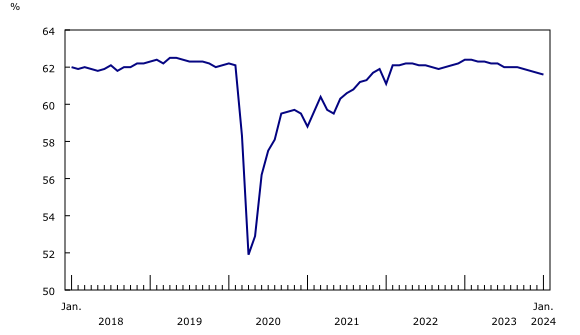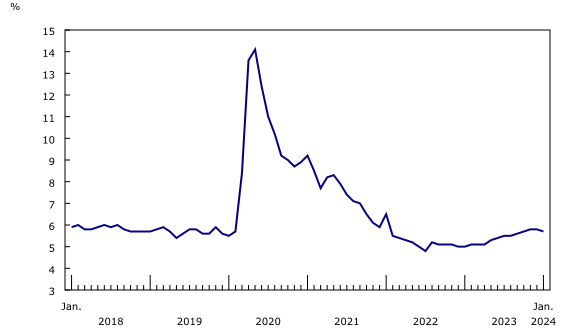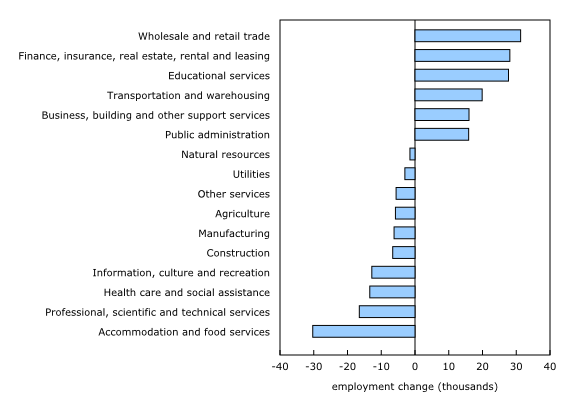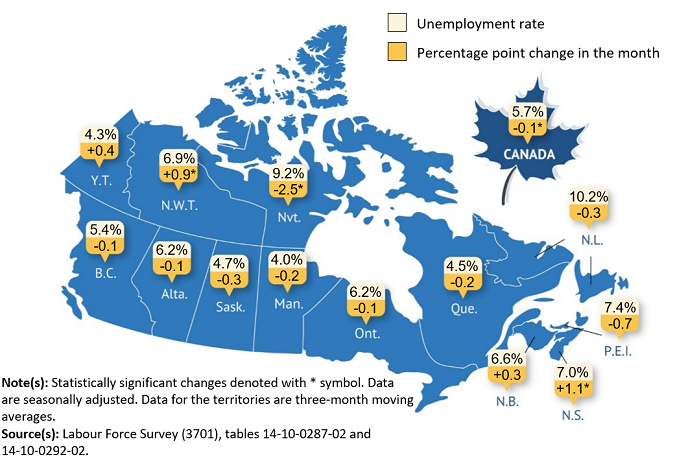Labour Force Survey, January 2024
Released: 2024-02-09
Highlights
Employment increased by 37,000 in January, following three months of little change. The employment rate fell 0.1 percentage points to 61.6%, as population growth (+0.4%) outpaced employment growth (+0.2%).
The unemployment rate fell 0.1 percentage points to 5.7%, the first decline since December 2022.
The participation rate fell 0.2 percentage points to 65.3% in January 2024, as the number of people in the labour force held steady and the population aged 15 and older rose.
Employment increased in Ontario (+24,000; +0.3%), Newfoundland and Labrador (+7,500; +3.2%), Manitoba (+6,900; +1.0%) and Nova Scotia (+3,700; +0.7%). It declined in Saskatchewan (-6,200; -1.0%).
There were employment gains spread across several industries in the services-producing sector, led by wholesale and retail trade (+31,000; +1.1%) as well as finance, insurance, real estate, rental and leasing (+28,000; +2.1%). There were declines in other industries, led by accommodation and food services (-30,000; -2.7%).
Total hours worked in January rose 1.1% from one year earlier and were up 0.6% in the month.
Average hourly wages among employees rose 5.3% on a year-over-year basis in January (+$1.74 to $34.75), following an increase of 5.4% in December 2023.
Employment rate declines for the fourth consecutive month
Following three months of little change, employment rose by 37,000 (+0.2%) in January 2024, driven by an increase in part-time work (+49,000; +1.3%).
The employment rate—the proportion of the working-age population that is employed—fell to 61.6% (-0.1 percentage points) in January, the fourth consecutive monthly decline, as the population aged 15 and older in the Labour Force Survey (LFS) grew by 126,000 (+0.4%) in the month. On a year-over-year basis, employment rose by 345,000 (+1.7%), while the working-age population, driven by permanent and temporary immigration, rose by 1.0 million (+3.1%), pushing the employment rate down 0.8 percentage points.
Following two months of little change, employment rose by 48,000 (+1.1%) among public sector employees in January. It was little changed in the month for private sector employees and self-employed workers. On a year-over-year basis, employment was up 4.1% for public sector employees (+174,000), up 1.6% for private sector employees (+210,000) and little changed for self-employed workers.
Employment rate falls among core-aged women and men and among young women
The employment rates of core-aged women and men (aged 25 to 54) both fell in January, as employment held steady while the population rose. The employment rate of core-aged women was 81.1%, down 0.3 percentage points in the month and down 0.9 percentage points from the record high of 82.0% observed in January and March 2023. Meanwhile, the employment rate of core-aged men fell 0.3 percentage points to 87.2% in January 2024, and was down 1.0 percentage points from the recent high of 88.2% recorded in June 2023.
The employment rate of young women aged 15 to 24 fell 0.7 percentage points to 56.0% in January 2024, and was down 4.7 percentage points from the recent high of 60.7% reached in January 2023. Since May 2023, the employment rate for female youth has remained below the pre-COVID-19 pandemic average of 59.9% in 2019.
Among young men, the employment rate held steady at 56.0% in January 2024 as the monthly employment increase (+14,000; +1.0%) kept pace with population growth for this group. However, the employment rate of male youth has generally followed a downward trend in the past year, declining 2.2 percentage points from January 2023 to January 2024.
Employment for men aged 55 and older rose by 17,000 (+0.7%) in January, partly offsetting the decline in the previous month (-23,000). Employment for women aged 55 and older was little changed in January.
Unemployment rate falls for the first time since December 2022
The unemployment rate fell 0.1 percentage points to 5.7% in January 2024. This was the first decline in the unemployment rate since December 2022. The unemployment rate had been on an upward trend through most of 2023, rising from 5.1% in April to 5.8% in December.
Participation rate falls
The participation rate—the number of people who are either employed or unemployed as a percentage of the population aged 15 and older—fell 0.2 percentage points in January 2024 to 65.3%.
The labour force participation rate fell 0.4 percentage points from January 2023 (65.7%) to January 2024 (65.3%), as the population not in the labour force increased (+4.5%; +493,000) at a faster rate than the total population aged 15 and older (+3.1%; +1.0 million).
People can be outside of the labour force at different ages for various reasons, including because they are going to school, providing care or performing household work, or because they have retired.
From January 2023 to January 2024, the number of persons not in the labour force who were going to school as their main activity rose by 172,000 (+10.0%). In January 2024, this group accounted for 16.1% of the population not in the labour force, up slightly from 15.3% in January 2023 (not seasonally adjusted).
More than half of those not in the labour force in January 2024 were retired. Although this group increased in size (+123,000; +2.0%) from January 2023 to January 2024, it decreased as a proportion of the population not in the labour force (-1.3 percentage points to 54.5%).
From January 2023 to January 2024, there were also increases in the number of persons not in the labour force whose main activity was caregiving and household work (+65,000; +4.4%) and in the number who were out of the labour force for other reasons (+132,000; +7.5%), a group that includes persons who had an illness or disability, were travelling or volunteering. The share of both groups of the population not in the labour force was little changed over the period.
Female youth participation rate falls to lowest point in over 20 years
On a year-over-year basis, the labour force participation rate has fallen more steeply among youth aged 15 to 24. In January 2024, the youth labour force participation rate was down 3.0 percentage points to 62.7% compared with January 2023. In comparison, the participation rate was down 0.3 percentage points to 88.6% for the population aged 25 to 54, and was little changed at 36.8% for the population aged 55 and older.
The participation rate of young women has followed a strong downward trend since February 2023, with a cumulative decline of 4.2 percentage points over that period. Excluding periods of public health restrictions during the pandemic, the participation rate for female youth in January 2024 was at its lowest level since May 2000. This reflected declines among both students and non-students. From January 2023 to January 2024, the participation rate of young women fell 3.9 percentage points to 47.0% for students, while it fell 2.1 percentage points to 85.5% for non-students (not seasonally adjusted).
For young men, the downward trend in the participation rate is more recent, with a cumulative decline of 2.9 percentage points from June 2023 to January 2024. In the 12 months to January 2024, the participation rate of young men fell more for non-students (-3.4 percentage points to 84.6%) than for students (-0.6 percentage points to 41.4%; not seasonally adjusted).
The downward trend in the overall youth labour force participation rate was accompanied by an increase in the youth unemployment rate, which rose 1.1 percentage points to 10.8% in the 12 months to January 2024, indicating that labour market conditions for youth have become more difficult in the past year.
Growth in hourly wages higher for women and for workers in the top quartile
In January, average hourly wages among employees were up 5.3% on a year-over-year basis (+$1.74 to $34.75), following an increase of 5.4% in December 2023.
From January 2023 to January 2024, average hourly wages rose at a faster pace for women (+6.2% to $32.38) than for men (+4.4% to $37.06). Wages rose at a similar pace for youth (+5.5% to $20.79) and core-aged (+5.4% to $37.41) employees over the same period, while they rose at a slower pace for people aged 55 and older (+3.7% to $35.72).
Average hourly wages rose 5.9% to an average of $60.58 for employees with hourly wages in the top 25% of the wage distribution in January 2024, compared with an increase of 4.6% (to $17.64 per hour) for those with hourly wages in the bottom 25% of the wage distribution (not seasonally adjusted).
Employment gains spread across the services-producing sector
Employment rose by 31,000 (+1.1%) in wholesale and retail trade in January, the first increase since June 2023. Employment in this industry had been on a downward trend from August to December 2023. On a year-over-year basis, employment in wholesale and retail trade was little changed in January 2024.
Employment fell in accommodation and food services (-30,000; -2.7%) in January, following seven months of little change. On a year-over-year basis, employment in accommodation and food services was also little changed in January.
Employment rose in finance, insurance, real estate, rental and leasing (+28,000; +2.1%) in January, partially offsetting a cumulative decline of 56,000 (-4.0%) observed from July to November 2023.
There were also increases in educational services (+28,000; +1.8%), transportation and warehousing (+20,000; +1.9%), business, building and other support services (+16,000; +2.4%) and public administration (+16,000; +1.3%) in January 2024. These increases were partially offset by declines in professional, scientific and technical services (-17,000; -0.9%) and information, culture and recreation (-13,000; -1.5%).
Employment up in four provinces in January, led by Ontario
Employment in Ontario increased by 24,000 (+0.3%) in January, partly offsetting a decline of 37,000 (-0.5%) in December. The employment rate in the province held steady at 60.8% in January, but was down 1.4 percentage points on a year-over-year basis. From January 2023 to January 2024, employment growth in Ontario (+1.1%) trailed growth at the national level (+1.7%), while the working-age population in the LFS grew at a faster rate in the province (+3.4%) compared with Canada as a whole (+3.1%).
Following six months of little change, employment in Newfoundland and Labrador increased by 7,500 (+3.2%) in January, while the unemployment rate was little changed at 10.2%.
Employment rose by 6,900 (+1.0%) in Manitoba in January, following little change in the previous three months. The unemployment rate in Manitoba was 4.0% in January, little changed in the month but down 1.5 percentage points from its recent peak reached in August 2023. In January 2024, the unemployment rate in Manitoba was the lowest among the provinces.
Following two months of little change, employment in Saskatchewan decreased in January (-6,200; -1.0%), partly offsetting gains in September and October 2023. At 4.7%, the unemployment rate was little changed in January 2024.
In January, employment in Quebec was little changed for the fourth consecutive month, and the unemployment rate held steady at 4.5%. In the 12 months to January, employment in Quebec was little changed, while the population aged 15 and older in the LFS grew by 1.9%. Consequently, the employment rate fell from 62.5% in January 2023 to 61.6% in January 2024.
For further information on key province- and industry-level labour market indicators, see "Labour Force Survey in brief: Interactive app."
Canada-US comparison: Unemployment rate unchanged in both countries
Comparisons between the labour market situation in Canada and in the United States can be made by adjusting Canadian data to US concepts. For more information, see "Measuring Employment and Unemployment in Canada and the United States – A comparison."
Adjusted to US concepts, the Canadian unemployment rate for people aged 16 and older remained at 4.8% in January, unchanged for the fourth consecutive month. In the United States, the unemployment rate was 3.7% for the third consecutive month.
Also adjusted to US concepts, the employment rate was 62.1% in Canada in January, compared with 60.2% in the United States. The employment rate has typically been higher in Canada than in the United States, but the gap has narrowed in the past year. From January 2023 to January 2024, the employment rate, adjusted to US concepts, fell by 0.8 percentage points in Canada while it held steady in the United States over the same period.
In the Spotlight: Labour market trends among Canada's Black population
February is Black History Month, a time to recognize and celebrate the rich contributions and accomplishments of Black people in Canada.
The population of Black Canadians reached 1.5 million in 2021, and is projected to reach more than 3.0 million by 2041. In January 2024, Black Canadians represented 4.4% of the labour force in Canada. The proportion was highest in Ontario (5.6%) and in Quebec (5.4%) (three-month moving averages, not seasonally adjusted).
In 2023, over 1 in 5 (21.6%) Black workers aged 25 to 54 worked in health care and social assistance. In comparison, 14.5% of all core-aged workers worked in the industry. Apart from health care and social assistance, core-aged Black workers were most likely to work in finance, insurance, real estate, rental and leasing (9.2%), manufacturing (8.1%), professional, scientific and technical services (8.0%), transportation and warehousing (7.2%) and retail trade (7.1%).
Despite their historic and continuing importance in the Canadian labour market, Black people continue to face barriers, including lower employment rates and lower wages.
The employment rate of Black Canadians in the core working age was 77.7% in January 2024, down from 79.8% a year earlier. In comparison, the employment rate for the overall core-aged population in January fell from 84.8% to 84.3% over that same period (three-month moving averages, not seasonally adjusted).
In 2023, the average hourly wage for core-aged Black Canadians was $30.83, compared with $36.27 for the total population. From 2022 to 2023, the average hourly wage for core-aged Black Canadians rose by 5.3%, while for the total population it rose by 5.0%.
In the Spotlight: Share of workers who plan to leave their job increases notably among youth in permanent employment
Changes in economic conditions, such as downturns and increases in the cost of living, can have an impact on the number of workers who choose to leave their job.
In January 2024, 6.9% of permanent employees were planning to leave their job in the next 12 months, up 0.5 percentage points compared with January 2022 (population aged 15 to 69, not seasonally adjusted).
Permanent employees who were planning to leave their job in January 2024 were most likely to do so to change careers (25.6%), because of low pay (19.1%) and to retire (14.7%). In comparison, in January 2022, 24.2% were planning to leave mainly to change careers, 17.6% due to low pay and 17.5% to retire.
Compared with January 2022, the share of permanent employees who planned to leave their job grew notably among youth (aged 15 to 24), rising by 4.2 percentage points to reach 14.9% in January 2024. In contrast, this proportion fell by 0.7 percentage points to 6.5% among those aged 55 to 69.
Intentions to leave are typically higher among employees earning lower wages. In January 2024, permanent employees with hourly wages in the bottom 25% of the wage distribution were more than twice as likely to indicate they were planning to leave their job in the next 12 months (11.7%) compared with those with wages in the top 25% (4.9%). This difference was also present in January 2022, but was smaller. From January 2022 to January 2024, the share of low-wage employees planning to leave grew by 2.3 percentage points, possibly reflecting stronger incentives to find a more highly paid job in the context of the increase in the cost of living.
Sustainable Development Goals
On January 1, 2016, the world officially began implementation of the 2030 Agenda for Sustainable Development—the United Nations' transformative plan of action that addresses urgent global challenges over the next 15 years. The plan is based on 17 specific sustainable development goals.
The Labour Force Survey is an example of how Statistics Canada supports the reporting on the Global Goals for Sustainable Development. This release will be used in helping to measure the following goals:


Note to readers
The Labour Force Survey (LFS) estimates for January are for the week of January 14 to 20, 2024.
The LFS estimates are based on a sample and are therefore subject to sampling variability. As a result, monthly estimates will show more variability than trends observed over longer time periods. For more information, see "Interpreting Monthly Changes in Employment from the Labour Force Survey."
This analysis focuses on differences between estimates that are statistically significant at the 68% confidence level.
LFS estimates at the Canada level do not include the territories.
The LFS estimates are the first in a series of labour market indicators released by Statistics Canada, which includes indicators from programs such as the Survey of Employment, Payrolls and Hours (SEPH); Employment Insurance Statistics; and the Job Vacancy and Wage Survey. For more information on the conceptual differences between employment measures from the LFS and those from the SEPH, refer to section 8 of the Guide to the Labour Force Survey (71-543-G).
Face-to-face personal interviewing resumed in November 2022. Telephone interviews continued to be conducted by interviewers working from their homes rather than Statistics Canada's call centres, as they have since March 2020. About 49,200 interviews were completed in January and in-depth data quality evaluations conducted each month confirm that the LFS continues to produce an accurate portrait of Canada's labour market.
The employment rate is the number of employed people as a percentage of the population aged 15 and older. The rate for a particular group (for example, youths aged 15 to 24) is the number employed in that group as a percentage of the population for that group.
The unemployment rate is the number of unemployed people as a percentage of the labour force (employed and unemployed).
The participation rate is the number of employed and unemployed people as a percentage of the population aged 15 and older.
Full-time employment consists of persons who usually work 30 hours or more per week at their main or only job.
Part-time employment consists of persons who usually work less than 30 hours per week at their main or only job.
Total hours worked refers to the number of hours actually worked at the main job by the respondent during the reference week, including paid and unpaid hours. These hours reflect temporary decreases or increases in work hours (for example, hours lost due to illness, vacation, holidays or weather; or more hours worked due to overtime).
In general, month-to-month or year-to-year changes in the number of people employed in an age group reflect the net effect of two factors: (1) the number of people who changed employment status between reference periods, and (2) the number of employed people who entered or left the age group (including through aging, death or migration) between reference periods.
Information on racialized groups
Data on "racialized groups" are derived from the "visible minority" variable. "Visible minority" refers to whether or not a person belongs to one of the visible minority groups defined by the Employment Equity Act. The Employment Equity Act defines visible minorities as "persons, other than Aboriginal peoples, who are non-Caucasian in race or non-white in colour." The visible minority population consists mainly of the following groups: South Asian, Chinese, Black, Filipino, Latin American, Arab, Southeast Asian, West Asian, Korean and Japanese.
Seasonal adjustment
Unless otherwise stated, this release presents seasonally adjusted estimates, which facilitate comparisons by removing the effects of seasonal variations. For more information on seasonal adjustment, see Seasonally adjusted data – Frequently asked questions.
Population growth in the Labour Force Survey
The LFS target population includes all persons aged 15 years and older whose usual place of residence is in Canada, with the exception of those living on reserves, full-time members of the regular Armed Forces and persons living in institutions (including inmates of penal institutions and patients in hospitals and nursing homes).
The LFS target population includes temporary residents—that is, those with a valid work or study permit, their families, and refugee claimants—as well as permanent residents (landed immigrants) and the Canadian-born.
Information gathered from LFS respondents is weighted to represent the survey target population using population calibration totals. These totals are updated each month, using the most recently available information on population changes, including changes in the number of non-permanent residents. LFS population calibration totals are derived from Canada's official population estimates using similar sources and methods, with minor adjustments being made to reflect exclusions from the LFS target population.
Because of the timing of the December 2023 reference week (December 3 to December 9), the period between the December and January estimates was longer (6 weeks) than for other months (4 or 5 weeks). This may lead to greater variations than are typical month to month, including higher growth in the population aged 15 and older.
Revisions to seasonally-adjusted Labour Force Survey tables
On January 29, 2024, revised LFS data were released, as is done every year, resulting in minor changes to recent estimates. Estimates from January 2021 to December 2023 were republished incorporating a fine-tuning of the parameters used in the seasonal adjustment process. Estimates from January 2024 onward also use the updated seasonal adjustment factors. For more information on the changes, see Labour Force Survey: Revisions, 2021 to 2023.
Next release
The next release of the LFS will be on March 8. February data will reflect labour market conditions during the week of February 11 to 17.
Products
More information about the concepts and use of the Labour Force Survey is available online in the Guide to the Labour Force Survey (71-543-G).
The product "Labour Force Survey in brief: Interactive app" (14200001) is also available. This interactive visualization application provides seasonally adjusted estimates by province, sex, age group and industry.
The product "Labour Market Indicators, by province and census metropolitan area, seasonally adjusted" (71-607-X) is also available. This interactive dashboard provides customizable access to key labour market indicators.
The product "Labour Market Indicators, by province, territory and economic region, unadjusted for seasonality" (71-607-X) is also available. This dynamic web application provides access to labour market indicators for Canada, provinces, territories and economic regions.
The product Labour Force Survey: Public Use Microdata File (71M0001X) is also available. This public use microdata file contains non-aggregated data for a wide variety of variables collected from the Labour Force Survey. The data have been modified to ensure that no individual or business is directly or indirectly identified. This product is for users who prefer to do their own analysis by focusing on specific subgroups in the population or by cross-classifying variables that are not in our catalogued products.
Contact information
For more information, or to enquire about the concepts, methods or data quality of this release, contact us (toll-free 1-800-263-1136; 514-283-8300; infostats@statcan.gc.ca) or Media Relations (statcan.mediahotline-ligneinfomedias.statcan@statcan.gc.ca).
- Date modified:






